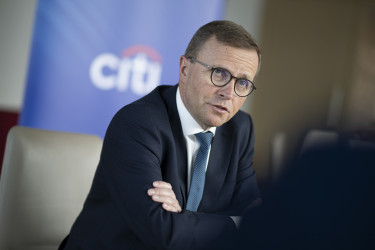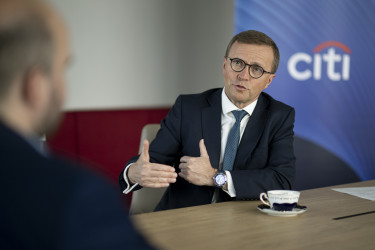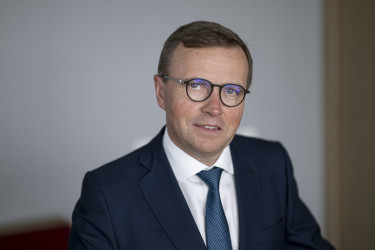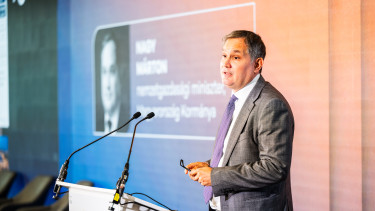The situation is tougher, but Hungary is well positioned – Citi’s global risk leader speaks out

First, let’s talk about your global strategic goals. What are your main objectives for this year and the coming years?
Our strategy is very much centered around the strength of our global network. Citi does business in more than 180 countries and jurisdictions, with a physical presence in over 90 countrie s, and we see that as a key differentiating factor in Citi’s competitiveness. We enable international clients to access local markets where we operate, and conversely, we help local clients expand internationally. We facilitate their entry into other countries and connect them to global capital markets—raising funds through syndications, bonds, equity offerings, and so forth.
How does this region, specifically Hungary, fit into this strategy?
Central and Eastern Europe play a significant role in this global strategy, and Hungary is a vital part of that.
Hungary hosts one of our largest and most mature operations in Europe. We have more than 3,000 employees here, across both our banking entity and our service center.
In fact, Hungary has been a part of our story for 40 years. I’m actually here now to celebrate that anniversary with clients, partners and colleagues. Personally, I have a strong connection to this location. I was the country head in Hungary from 2002 to 2005. During that time, we laid the groundwork for our Citi Solutions Center Budapest (CSC), which we officially opened in 2005. At the beginning, we had about 50–60 people and were planning to scale up the CSC to 500. Today, we have over 3,000 colleagues at Citi in Hungary, with the majority of working in the Solutions Center. The country has a stable economy and a diverse client base, including both domestic and international clients, as well as financial institutions. Hungary remains very important to us.

How would you describe the global challenges Citi is currently facing — from the tariff war to the Russia–Ukraine conflict — and how do you manage these as a global bank?
Given that we do business in more than 180 countries and jurisdictions, we are quite used to managing through a variety of complex and often difficult environments. At any given moment, there’s likely a crisis unfolding somewhere. Of course, the Russia–Ukraine conflict is devastating, and personally, I sincerely hope it will come to a peaceful resolution soon. We continue to support our clients in the region, including those in Ukraine.
From a risk management perspective, we know how to navigate such geopolitical situations. We have experience and systems in place to respond effectively. The issue of tariffs, however, presents a different type of challenge. It’s reshaping global trade flows and the way international clients conduct their operations. The landscape is still evolving—there are ongoing negotiations, shifting deadlines, and a lot of uncertainty.
But what’s already clear is that
companies will need to rethink their global supply chains. Clients must now prepare for increased volatility, which is likely to persist for some time.
This environment is also influencing investment flows. Institutional investors, such as asset managers overseeing large portfolios, must now take a different approach to diversification and positioning. That’s where Citi comes in. We can help clients restructure their supply chains and fund new investments in emerging or strategic markets. We provide support in areas like hedging, as well as in our core strengths —markets and custody services— especially relevant to investment management. These are challenging times, no doubt. I do believe globalization will continue, but it will look different. It’s being redefined by current events.
As the Global Chief Risk Officer of Citigroup, from a risk perspective, which activities or sectors are most affected by the tariff wars, in your view?
From a risk standpoint, certain industries are definitely more impacted than others. The automotive industry is a prime example. Even before the tariff tensions, the sector was already undergoing a major transformation — transitioning from traditional combustion engines to electric vehicles. Now, on top of that shift, we see increasing pressure—particularly in the U.S.—toward domesticating production. That creates new challenges for global supply chains and for companies operating across borders.
We also need to consider the impact at the country level. Some countries have had significant dependencies on exports, particularly to the United States. With new trade agreements and tariff regimes, there are implications not only for those countries’ export capacity but also for their broader macroeconomic performance. In this environment, clients need to be better protected against volatility—whether it’s in currencies, interest rates, or commodity prices. That’s a major area of focus for us.
From a business perspective, would you describe this year as a time for growth or more about managing risks?
I’d say it’s both. There are certainly significant risks right now, and the current global environment is generating new ones. But at the same time, risk often brings opportunity. For example, some of our clients are having to build entirely new factories or shift their supply chains—moving from reliance on a single emerging market to diversifying across three or four different countries. These are complex challenges, but they also open up new business avenues. While I can’t quantify how much opportunity there will be in financial terms, what I can say is that every crisis creates both obstacles and opportunities.
To what extent do you see Hungary—or this broader region—exposed to these global risks? Would you say Hungary is on the front lines or more shielded?
First and foremost, Hungary is part of the European Union. So, how the EU as a whole responds to the evolving trade dynamics—particularly the emerging trade agreement between the U.S. and the EU—will be a major factor. In my personal view, there’s a high degree of mutual dependency between Europe and the U.S., which creates a real opportunity to reach a solid and balanced agreement. But it’s something we need to monitor closely. When it comes to Hungary specifically, exports to the U.S. are relatively limited. So, the direct impact may not be severe.
The greater concern would be indirect effects—if trade tensions escalate and lead to broader economic slowdowns, other European countries, including Hungary, could feel the repercussions. That said, Hungary has also benefited from alternative trade corridors, particularly with Asia. We’ve seen a significant level of investment here from Asian countries, which helps provide a counterbalance to risks in other regions. All things considered, when I look at the global map of the countries where we operate, Hungary is relatively well-positioned.
During the pandemic, we already saw a breakdown in global supply chains. Would you say today’s situation is even more complex or difficult than during the pandemic?
I believe it has become even more complex. During the pandemic, the primary issue was diversification. If one market experienced disruption, companies could turn to others to compensate. The challenge was managing those dependencies and building resilience. Now, however, the situation includes additional layers.
We’re facing unpredictable trade arrangements and ongoing uncertainty around future agreements. At the same time, there’s increasing pressure—especially from the U.S.—to bring parts of production back home, which many companies will need to address strategically. So overall, this environment is more complicated and more difficult for most of our clients to navigate.

In recent years, banks—especially in the U.S. and Western Europe—have benefited from higher interest rates. Do you think that’s still enough to sustain banking profitability, considering the risks you mentioned?
You're right — higher interest rates typically help boost net interest margins, which supports profitability. But in Citi’s case, we’ve also been very successful and profitable during periods of very low, or even negative, interest rates in some markets. The key lies in our business model and its diversity. When interest rates are low, there are other business opportunities—clients are more active in M&A, and they tend to raise more capital to take advantage of cheaper financing. So, in a diversified model like ours, different products perform better at different times. I’m not too concerned. However, I do think that
banks with less diversified, single-product-focused models — especially those heavily reliant on lending—may feel more pressure in the current environment.
Looking at your global portfolio, which business areas are performing more strongly this year, and which are showing signs of weakness?
We’re still seeing strong client activity, especially in areas like cash management and foreign exchange. These flows remain healthy. Borrowing activity is somewhat mixed, as clients are being more cautious and strategic about their next moves. In investment banking, M&A activity is present—perhaps not at peak levels, but we have a solid pipeline.
Where we see more weakness is in equity-related activities. Equity issuance is subdued, as many investors are waiting to see where market valuations settle. On the bond side, especially in the investment-grade segment, we’re seeing significant refinancing activity. There’s plenty of liquidity in the market, strong investor interest, and Citi continues to play an active role in those flows.
After the financial crisis, Citigroup went through a major transformation, particularly in terms of its balance sheet and global network. Is that transition still affecting your operations, or is it now fully behind you?
We've executed a large part of our strategic transformation. One major area was the significant reduction of our global consumer banking exposures—that process is essentially complete. Hungary was part of that some years ago as well. On the corporate and investment banking side, we haven’t undergone any major restructuring. We remain fully committed to operating in all the markets where we are present.
As I mentioned earlier, facilitating global client activity remains a core priority. In addition, we’ve launched a broader transformation program at Citi focused on process improvement and simplification. That’s also well underway and progressing successfully.
Is there any chance that Citigroup might return to retail banking in the foreseeable future in Hungary?
I don’t think so—not in the foreseeable future. Our strategic focus remains on corporate and institutional clients here.
What kind of changes have you seen in client needs or behavior in recent years, and how have you adapted?
One of the biggest trends is, without a doubt, digitalization. When I was here in Hungary in 2004–2005, some clients still sent us instructions via fax machines. Today, around 98% of all flows are processed directly through electronic banking platforms. The same shift applies to trading—automation and digital platforms have transformed the way clients interact with us. We continue to invest heavily in technology to stay ahead of the competition in this area. Another major trend is how clients are now leveraging capital markets much more actively.
In the past, over 90% of corporate financing was loan-based. Loans were the central product, and banks would often receive a large share of a client’s overall business because of that lending relationship. Today, that model has changed.
Clients have more choices: they can secure direct loans, enter syndications, issue bonds, or explore hybrid structures. As a result, every product—be it market-related, service-related, or trade finance—is now competed for separately. That has changed the mindset not just for clients, but for us as well.
We must remain competitive in each specific area of client interest. Client treasury operations have also become much more sophisticated. Cash is no longer just sitting idle in accounts. Clients want to optimize their working capital, improve financing efficiency, and reduce capital tied up unnecessarily. Liquidity in trade instruments has become vital. And of course, risk management is another key area — especially hedging.
Clients no longer want to passively accept market movements. Many are building their own hedging strategies, and when they need more complex or large-scale solutions, they turn to banks like us. And it's not just about currencies anymore — interest rate hedging has become increasingly important, especially in this dynamic rate environment. We’re seeing a lot of demand in that space, where we are well positioned to support our clients’ needs.

Fintechs, big tech, and other non-traditional players are increasingly gaining market share. How do you see this development? Do you view these players as competitors, or are you more inclined to cooperate with them?
It’s important to distinguish between retail and corporate activities when interpreting these statistics. Most of the areas where we operate today—corporate and investment banking—primarily serve large clients: multinational corporations, financial institutions, fund managers, hedge funds, and so on. These clients may use fintech solutions, but it’s not their core mode of operation. Fintechs are more often used for efficiency enhancements or as benchmarks to observe how the industry is evolving.
As for us, we take a balanced approach. In some cases, we cooperate with fintech companies; we even invest in some of them. We also use them to benchmark ourselves—to assess how competitive we are and how we can enhance the solutions we offer to clients. Ultimately, our goal is to continue being one of the best choices for our clients, even in a rapidly evolving environment.
Artificial intelligence has moved beyond being just a buzzword — it’s clearly becoming a game changer. Are there any use cases at Citi where you're already leveraging AI?
Absolutely. AI is indeed a game changer, and not just in banking — it’s redefining many industries. As a Chief Risk Officer, I view AI from two perspectives. First, how Citi can benefit from it. And yes, we are already integrating AI into our operations in a very deliberate way. For example, employees use our AI tools to compare documents and conduct advanced fact searches — such as navigating complex risk policies.
We’re also using AI in areas like -programming and model risk management. The number of AI applications is growing steadily, and we’re investing heavily in this area. Just yesterday, I visited our service center here in Hungary, where they are hosting an “AI Week.” Trained colleagues are showcasing our AI capabilities and educating others — demonstrating how Citi’s AI tools can support innovation and encouraging them to think creatively about potential applications.
However, the second perspective is about risk. As AI reshapes industries, it will benefit some players while disadvantaging others. This shift matters greatly in risk management — we must analyze the potential impact AI could have on our clients and their business models. And we must also acknowledge the darker side: AI is being used not just by responsible actors, but also by malicious ones—cybercriminals, fraudsters, and others.
That means we must learn how to defend against AI-enabled threats and use AI ourselves to combat them. This creates new demands for capacity, as well as entirely new skill sets within the risk organization.
You mentioned your Citi Solutions Center in Budapest. I feel we don’t highlight it enough. How would you describe its significance within Citi’s global operations?
Yes, it's one of our key Solutions Centers globally. We have others in the U.S., in Europe, in the UK, in Asia—but the Budapest Solutions Center is sizable. The range of activities it supports is broad: a large part is focused on technology, but there’s also finance, accounting, reporting, and more.
From my perspective in risk management, we use it for third-party risk management, as well as for analytical and modelling capabilities. In total, there are over 20 different groups operating from Budapest providing services for Citi worldwide, each with its own responsibilities. What truly sets our Centers apart is the quality of the people. The technologists, for example, are top notch, and we rely on them for advanced, sophisticated tasks. It's not the typical perception of a service center, where people are only responding to phone calls or doing basic data entry. Far from it.
We have senior-level staff here and they are engaged in complex work—like quantitative model analysis and other high-value-added activities.

How would you describe the journey from leading Citi Hungary 20 years ago to holding one of the top global roles today? How challenging was that path?
Honestly, I wouldn't say it was difficult — I’ve always loved working at Citi. I joined back in 1991, so it's been nearly 34 years. When I moved to Hungary in 2002, it was a big step. The markets I’d worked in previously were less developed, and Hungary was already attracting significant foreign investment and had more advanced financial products. I learned a lot during my time here. In every move I made, there was always something new to learn. Of course, you need to prove yourself to earn the next opportunity, but each role came with new experiences and challenges that added to my growth.
Now, in my current role, I feel I’m able to draw on all that accumulated experience. One of the things I love about working in Risk Management is that you get to see everything — every client segment, every product. You have to think about what can go wrong, but you can also help to create the right solutions. You can help clients navigate volatility, structure deals, and manage exposures. It’s incredibly rewarding.
Sometimes you look back and realize that, thanks to your contribution, a client was able to build a new factory, enter a new market, or avoid a significant loss in a volatile environment. That’s the kind of impact that makes this job truly meaningful, and rewarding.
Photos by: András Hajdú D. / Portfolio
A cikk elkészítésében a magyar nyelvre optimalizált Alrite online diktáló és videó feliratozó alkalmazás támogatta a munkánkat.








